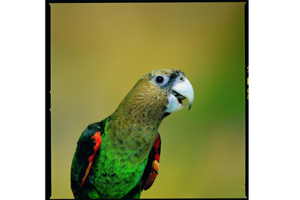New parrot species found hiding in plain sight
The discovery that Africa's Cape Parrot is a distinct species highlights the importance of genetic analysis to conserving wildlife.

This is a male Cape Parrot (Poicephalus robustus).
Cyril Laubscher
Sometimes, discovering new animal species requires spending years venturing deep into the wilderness. But other times, a new species can be found hiding in plain sight.
The Cape Parrot, a largish bird native to the forests of South Africa, has long been considered, along with the brown-necked parrot and the grey-headed parrot, to be a subspecies of Poicephalus robustus. But a genetic analysis suggests that the Cape Parrot is its own distinct species, one that resulted from natural selection and not breeding.
Next, conservationists will try to have Cape Parrot recognized as a separate species, which could qualify it to be listed as "vulnerable" under the International Union for Conservation of Nature and Natural Resources' Red List of Threatened Species, according to the study.
The discovery, published in the journal PLOS ONE Thursday, highlights the increased role that DNA testing plays in discovering new species in unexpected places. Experts say that islands, capes, and separate river systems in the United States all hold the promise of finding these new species-within-species.
Last year, scientists with the Wildlife Conservation Society (WCS) used genetic testing to determine that humpback whales in the Arabian Sea are the most genetically distinct humpback whales in the world, and may be the most isolated whale population. The results suggest that this population remained separate from other humpback whale populations for perhaps 70,000 years.
“We use DNA evidence to identify unique and different populations – and sometimes even new species – of whales and dolphins,” writes Howard Rosenbaum, Director of WCS’s Ocean Giants Program in an email. “This type of information is often invaluable for regulatory authorities, managers, and the scientific community to design and implement the most appropriate conservation strategies to protect them.”
In 2014, a DNA test revealed a new species of dolphin, the ‘Araguaian dolphins,’ which had managed to remain genetically isolated from other dolphin species in the Araguaia River basin of central Brazil for two million years.
“I’m interested in how we use science to make good decisions, but also looking at the economics of these protections as well.” says Joe Roman, a conservation biologist at the University of Vermont’s Gund Institute and author of Listed: Dispatches from America's Endangered Species Act.
He says in an interview that his job is to examine the science and policy of endangered species protection. “I’m interested in how we use science to make good decisions, and also looking at the economics of these protections, so we can make good decisions.”
“There’s been a rapid rise in using conservation genetics and taxonomy to define populations. The field of biogeography has been booming lately,” Roman says. “The world is in the middle of a conservation crisis, but at the same time we’re seeing more and more species described.”
He adds, “Part of that is because we’re going into new areas, but in a large part, it’s because we’re doing more genetic and morphological analysis of these species.”
Dr. Roman was part of the team that used genetic testing last year to determine that the alligator snapping turtles in Florida are a separate and distinct population and a new species.
“This is a turtle that has been proposed for listing as endangered in the United States,” he says. “Our finding that a single population in the Suwanee River in Florida and in Georgia is actually a species that’s been separated for hundreds of thousands of years brings this conservation issue to the forefront.”
“Species can look the same," he adds, "even if they’re found across a large range. And once you look at the DNA, you might discover that maybe a mountain range or a river drainage has split it into separate groups that have been in isolation long enough that we consider them species or sub-species."
According to Roman, the greatest obstacles to using this new technology to save species are money and time.
Wildlife biologist and outspoken conservationist Forrest Galante says in an interview, “Without knowing that these specific groups of animals are genetically isolated we may not consider them valuable or vulnerable and may directly or indirectly wipe out entire genetic populations even though they may look or act very similar to a different group of animals.”
“The more we can understand about wildlife (population genetics) the better we can protect it, so DNA testing is very important to establish boundaries for human/wildlife interactions on a global scale,” Mr. Galante adds.
“Genetics is incredibly informative and essential in most conservation efforts but sometimes you have a small population on the verge of extinction and you don’t have the time to do the genetic studies before you make the decision,” Roman adds. “In most cases the thing you want to do is protect the habitat and then understand its ecology and genetics. I think we need a suite of tools to protect species. We need studies that proceed rapidly but are informed by science, and genetics is one of the tools we have in our conservation tool kit.”
However, Roman points out, “We don’t have endless money. Science takes a while and it takes funding. Lack of funding is always an obstacle.”

